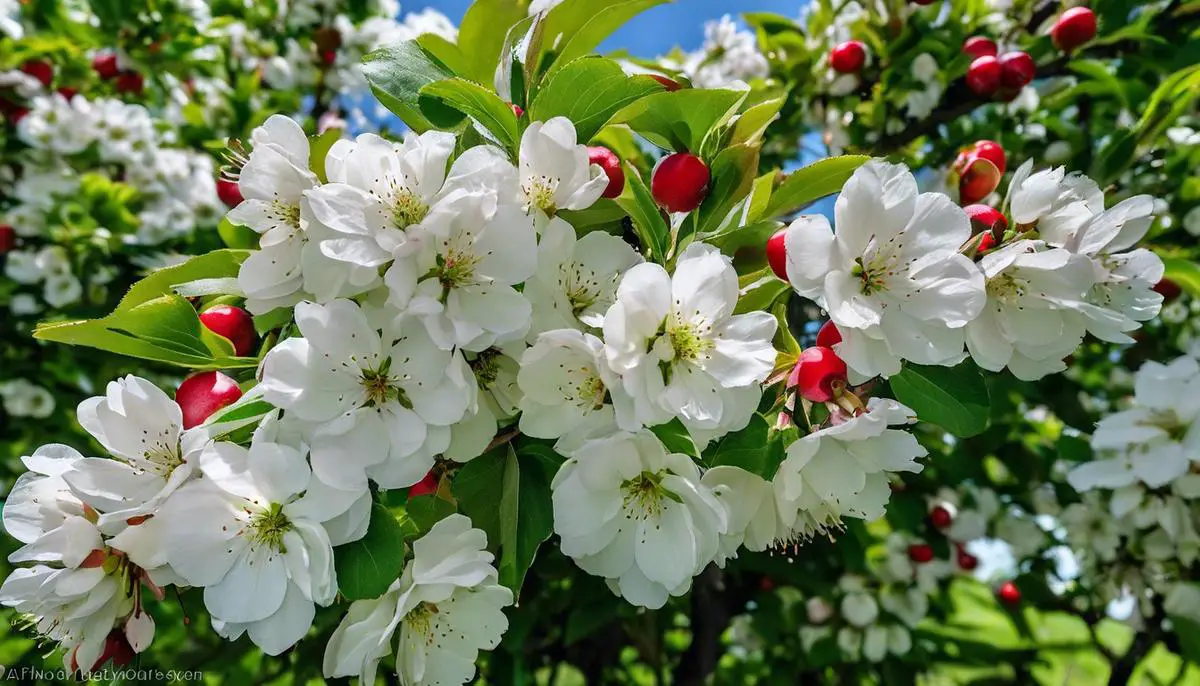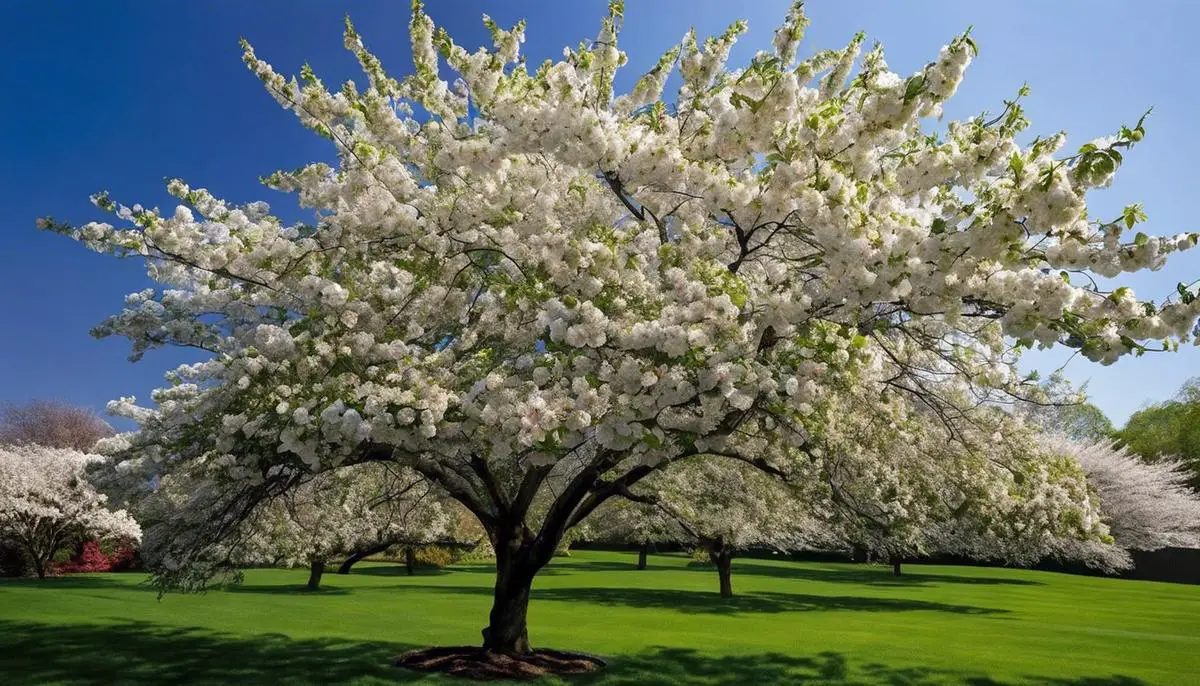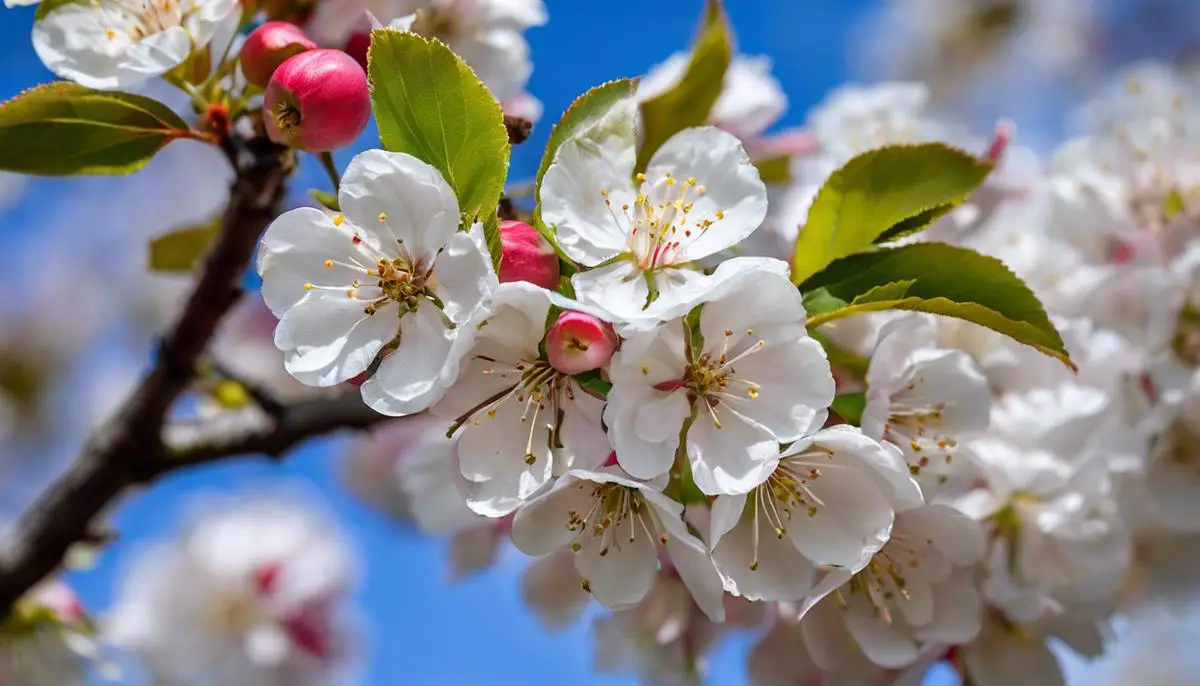Embracing a beauty that transcends seasons, the Snowdrift Crab Apple tree stands as a testament to nature’s grandeur. This ornamental gem is renowned for its impressive exhibit of snowy blossoms during spring and its enthralling array of small, vivid fruits in the fall. In the succeeding discourse, we’ll be delving into the heart of what the Snowdrift Crab Apple is all about. From understanding its origins, botanical attributes, and cultivation necessities to its hardiness zones, the pages that unfold will acquaint you intimately with this tree’s unique characteristics and seasonal charm.
Additionally, our focus will extend beyond the surface allure to examine how to plant and care for your very own Snowdrift Crab Apple, providing a concise guide on ideal conditions, preferred soil type, sunlight, and water necessities. More so, we will highlight essential ongoing care tips, and insights into effective pruning, pest control, disease management, and maintenance for this tree species.
Understanding Snowdrift Crab Apple
The Singular Allure of the Snowdrift Crab Apple
A name as colorful and interesting as the Snowdrift Crab Apple catches the eye and appeals to the imagination. This charming tree is not only visually captivating but also has an impactful role in the world of horticulture. But what exactly is a Snowdrift Crab Apple, and what sets it apart from its fruit tree cousins?
Starting with a little botany lesson, the Snowdrift Crab Apple, scientifically known as Malus ‘Snowdrift’, is a widely-admired deciduous tree. A member of the Rosaceae family, it’s best known for its vibrant spring blossoms and its ornamental crabs. Surpassing the ordinary, the blooming of the Snowdrift Crab Apple is a spectacular sight as it blankets the tree in a flurry of white petals, providing an uncanny resemblance to a snowbank – thus the name, Snowdrift.
Designed by nature to enchant through every season, the Snowdrift Crab Apple offers not only a stunning spring show but maintains visual interest throughout the year. After blooming, the tree, growing to a fair height of 15 to 20 feet, produces shiny, green foliage, playing host to a smattering of small, red-colored apples. These fruits, while not typically used for eating, are a treat for local bird populations. As autumn arrives, the foliage gracefully changes to a warm, inviting, golden-yellow, creating a seasonal spectacle that doesn’t disappoint.
Unique among fruit trees, the Snowdrift Crab Apple is both resilient and hardy. It’s a tree that prefers full sun but tolerates partial shade. Further adding to its charm, this crab apple variant is an excellent pick for gardeners, both novice and veteran, as it’s relatively low-maintenance, tolerating different soil types and conditions.
Perhaps the most compelling feature of the Snowdrift Crab Apple is the ecological benefits inherent to its existence. A veritable powerhouse, providing nourishment to various bird species and acting as a pollinator magnet, this tree contributes significantly to local ecosystems.
Furthermore, the Snowdrift Crab Apple doesn’t just bring beauty and ecological contributions to the table; it’s a game-changer in the realm of landscape design. It’s a fantastic choice for anyone desiring to add year-round visual interest to a home garden or public space.
In conclusion, the Snowdrift Crab Apple isn’t just an ordinary fruit tree. It’s an embodiment of natural beauty, practical function, and ecological importance rolled into one adaptable package. So next time you spot those glorious snow-like blossoms or a flurry of birds feasting on bright red fruits, you’ll know you’re in the delightful presence of the one and only, Snowdrift Crab Apple.

Planting and Care for a Snowdrift Crab Apple Tree
Planting and caring for a Snowdrift Crab Apple Tree is an enjoyable and rewarding pastime that doesn’t necessarily require a green thumb. It just needs a bit of knowledge, enthusiasm, and careful attention. Let’s delve right into the steps needed.
Firstly, deciding where to plant your tree is paramount. Considering the height (15 to 20 feet) and spread (15 to 20 feet), you should allow enough room for growth. Equally important is sun exposure. A Snowdrift thrives in full sunlight and requires at least six hours of direct, unfiltered sunlight each day. Choose a well-drained site, as these trees are not fans of overly wet roots.
Prior to planting, soak the roots of your tree in water for several hours. Dig a hole three times wider than the root ball and as deep. The widest part of the root should be level with or slightly above the surface. Place the tree in the hole and backfill with the original soil.
Water your newly planted tree immediately, and ensure it receives a good soak once a week during the first year. Regular watering encourages the roots to grow deep and strong. Make sure not to exceed watering as overly saturated soil can lead to root rot.
Mulching around the base of the tree aids in retaining soil moisture and controls weed growth. Use organic mulches like wood chips or shredded bark, extending it to the drip line of the tree but be careful not to mound it against the trunk.
As for feeding, Snowdrift Crab Apple trees benefit from an annual application of a slow-release, balanced fertilizer. Apply in early spring to give the tree a nutrient boost for the growing season. However, avoid heavy fertilizing which can lead to overly vigorous growth that’s more susceptible to diseases and pests.
Pruning is another vital step in the care regimen. The best time to prune is late winter or early spring before new growth begins. Remove dead or diseased branches, suckers, and any branches that cross or rub against each other.
Lastly, Snowdrift Crab apples are famed for their disease resistance, yet like any plant, they can be susceptible to pests like aphids and certain types of fungus. Regular inspection of your tree helps catch potential issues early. Pesticides or fungicides can be used when needed, always following label instructions.
Caring for a Snowdrift Crab Apple can be a truly fulfilling hobby. With just a bit of dedication and care, your tree will flourish, gracing your landscape with a splendid display of white blossoms and offering ecological benefits such as attracting pollinators and providing food for wildlife. Happy Gardening!

The Snowdrift Crab Apple’s Ecological Contribution
The Snowdrift Crab Apple tree offers more than just a visual feast of blossoms in spring or a plentiful supply of fruit in fall; it also has significant benefits to the environment. Its ecological contributions cannot be overstated, making it not just a great addition to landscapes but also a boon to nature.
Rightly tagged as a wildlife magnet, this tree is known to attract various species. Its blooms are rich in nectar and pollen, making it a favorite hangout of bees, butterflies and other types of pollinators, which help to fertilize flowers leading to the production of seeds. When we expand our view beyond our backyards, we realize this very action ensures the survival of our wild flora, resulting in a knock-on effect on the wider ecosystem.
As fall descends and the fruit of the Snowdrift Crab Apple ripens, it doesn’t just cater to our taste buds. These fruits can become an important autumn and winter food source for wildlife species. Robins, cardinals, grosbeaks, and cedar waxwings are some of the bird species that can often be seen feasting on crab apples. Many times, the fruit will persist on the tree well into winter, providing a much-needed source of food during the lean winter months when other sources are scarce.
Moreover, the tree itself provides habitat and shelter for many types of birds and small animals. Its dense, rounded canopy of leaves creates a rich tapestry of hiding and nesting spots for our feathered and furry friends. The tree becomes a mini-ecosystem in itself, housing various flora and fauna and helping various species survive and thrive.
In the grand scheme of things, these trees also play a vital role in improving air quality. Like all other trees, Snowdrift Crab Apple trees absorb carbon dioxide from the atmosphere and release oxygen into the air. Besides acting as a carbon sink, their leaves also work tirelessly to absorb and filter out various pollutants, making the air cleaner and healthier for us to breathe.
One more ecological benefit worth noting is soil erosion prevention. The roots of the Snowdrift Crab Apple tree help hold the soil together, reducing the risk of soil erosion, particularly in hilly landscapes or areas prone to flooding. Also, their leaf litter contributes to soil health by adding organic matter, maintaining soil moisture, and preventing weed growth.
In conclusion, the Snowdrift Crab Apple tree does a great deal more than win admirers with its appealing appearance. Its true beauty lies in its ecological benefits which play an invaluable role in nurturing diverse wildlife and seasoning our environment with the spice of sustainability.

While Snowdrift Crab Apple has considerable aesthetic appeal, its most significant contributions are not readily visible. Their ecological significance is immense, starting from their ability to attract a plethora of wildlife, fortify biodiversity, provide valuable food and habitat, to their role as a native species, these trees are a powerhouse of environmental benefits. All the while, they also serve as potent allies in the fight against climate change through their capability for carbon storage.
Whether you seek to enrich your garden’s spectacle or make a valuable ecological contribution, the Snowdrift Crab Apple stands as a testament to nature’s diverse beauty and resilience. Shaded under its rounded canopy of flowers or admiring the clusters of autumn fruit, you’ll find the Snowdrift Crab Apple isn’t just a tree—it’s a tribute to the harmony of nature and an invite to join the cause in preserving our precious ecosystems.
